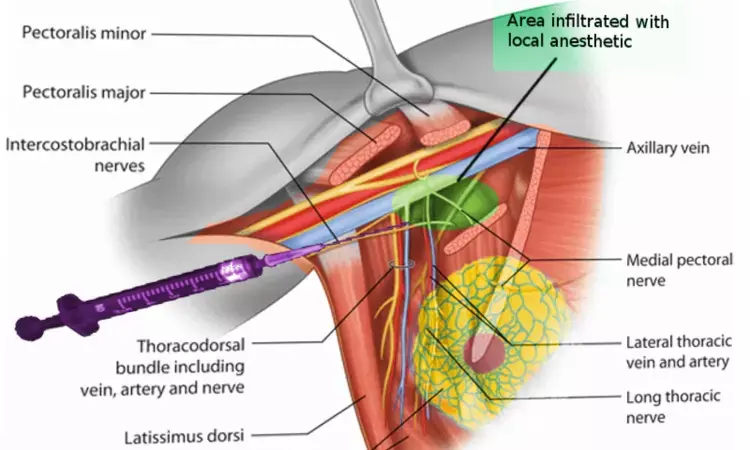- Home
- Medical news & Guidelines
- Anesthesiology
- Cardiology and CTVS
- Critical Care
- Dentistry
- Dermatology
- Diabetes and Endocrinology
- ENT
- Gastroenterology
- Medicine
- Nephrology
- Neurology
- Obstretics-Gynaecology
- Oncology
- Ophthalmology
- Orthopaedics
- Pediatrics-Neonatology
- Psychiatry
- Pulmonology
- Radiology
- Surgery
- Urology
- Laboratory Medicine
- Diet
- Nursing
- Paramedical
- Physiotherapy
- Health news
- Fact Check
- Bone Health Fact Check
- Brain Health Fact Check
- Cancer Related Fact Check
- Child Care Fact Check
- Dental and oral health fact check
- Diabetes and metabolic health fact check
- Diet and Nutrition Fact Check
- Eye and ENT Care Fact Check
- Fitness fact check
- Gut health fact check
- Heart health fact check
- Kidney health fact check
- Medical education fact check
- Men's health fact check
- Respiratory fact check
- Skin and hair care fact check
- Vaccine and Immunization fact check
- Women's health fact check
- AYUSH
- State News
- Andaman and Nicobar Islands
- Andhra Pradesh
- Arunachal Pradesh
- Assam
- Bihar
- Chandigarh
- Chattisgarh
- Dadra and Nagar Haveli
- Daman and Diu
- Delhi
- Goa
- Gujarat
- Haryana
- Himachal Pradesh
- Jammu & Kashmir
- Jharkhand
- Karnataka
- Kerala
- Ladakh
- Lakshadweep
- Madhya Pradesh
- Maharashtra
- Manipur
- Meghalaya
- Mizoram
- Nagaland
- Odisha
- Puducherry
- Punjab
- Rajasthan
- Sikkim
- Tamil Nadu
- Telangana
- Tripura
- Uttar Pradesh
- Uttrakhand
- West Bengal
- Medical Education
- Industry
Meta-analysis assesses two different Approaches for Infraclavicular Brachial Plexus Block

Recent meta-analysis compared the classical and costoclavicular approaches for ultrasound-guided infraclavicular brachial plexus block (ICB) in terms of onset, performance, and safety. The primary outcomes included sensory and motor block onset time, the number of patients with complete block at 30 minutes, and the secondary outcomes encompassed block performance time, number of attempts, duration of the block, and any incidence of complications. The review included five trials with 374 adult patients and found no significant difference in sensory and motor block onset times and block performance time between the classical and costoclavicular approaches of ICB. Additionally, the number of patients with complete block at 30 minutes did not significantly differ between the two approaches. The meta-analysis revealed no statistically significant differences in motor block duration, number of attempts and redirections, duration of the block, or the incidence of complications between the classical and costoclavicular approaches. The overall level of evidence for most outcomes was low, suggesting that further studies are warranted to confirm the findings.
Lack of Standardization and Limitations
The review highlighted the lack of standardization in classical and costoclavicular approaches, particularly in the volume and type of local anesthetic used, which led to inconsistent onset and duration measurements. The meta-analysis also noted heterogeneity in outcome definitions and inconsistent follow-up methods as limitations affecting the assessment of block duration between the two techniques. The review also emphasized the need for further research to address these limitations and provide more definitive evidence on the superiority of the costoclavicular approach.
Implications
In conclusion, the review and meta-analysis revealed that the costoclavicular approach was not superior or inferior to the classical technique for infraclavicular brachial plexus block. However, the quality of evidence was low, and further studies are needed to corroborate the findings. The review also highlighted the need for addressing limitations and the underutilization of emerging techniques, such as the costoclavicular approach, for informed clinical practice and further research in ICB techniques.
Key Points -
- A systematic review and meta-analysis compared the classical and costoclavicular approaches for ultrasound-guided infraclavicular brachial plexus block (ICB) in terms of onset, performance, and safety. The primary outcomes included sensory and motor block onset time, the number of patients with complete block at 30 minutes, and the secondary outcomes encompassed block performance time, number of attempts, duration of the block, and any incidence of complications. The review included five trials with 374 adult patients and found no significant difference in sensory and motor block onset times, number of patients with complete block at 30 minutes, and block performance time between the classical and costoclavicular approaches of ICB. The meta-analysis also revealed no statistically significant differences in motor block duration, number of attempts and redirections, duration of the block, or the incidence of complications between the classical and costoclavicular approaches. The overall level of evidence for most outcomes was low, suggesting that further studies are warranted to confirm the findings.
- In conclusion, the review and meta-analysis revealed that the costoclavicular approach was not superior or inferior to the classical technique for infraclavicular brachial plexus block. However, the quality of evidence was low, and further studies are needed to corroborate the findings. The review also highlighted the need for addressing limitations and the underutilization of emerging techniques, such as the costoclavicular approach, for informed clinical practice and further research in ICB techniques.
Reference –
Garg, Heena, Makhija, Purva, Jain, Dhruv, Kumar, Shailendra, Kashyap, Lokesh. Comparison of the classical approach and costoclavicular approach of ultrasound-guided infraclavicular block: A systematic review and meta-analysis. Indian Journal of Anaesthesia 68(7):p 606-615, July 2024. | DOI: 10.4103/ija.ija_1124_23
MBBS, MD (Anaesthesiology), FNB (Cardiac Anaesthesiology)
Dr Monish Raut is a practicing Cardiac Anesthesiologist. He completed his MBBS at Government Medical College, Nagpur, and pursued his MD in Anesthesiology at BJ Medical College, Pune. Further specializing in Cardiac Anesthesiology, Dr Raut earned his FNB in Cardiac Anesthesiology from Sir Ganga Ram Hospital, Delhi.


